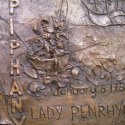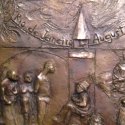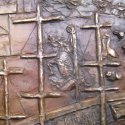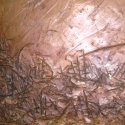Memory and narrative
The women on the Lady Penrhyn
(Mary Springham and her First Fleet story) 2010
The voyage of the Lady Penrhyn
8 reliefs, lost wax bronze, each 480 mm X 400 mm.
Cast by Meridian Sculpture Foundry
1 ‘When I grow rich say the bells of Shoreditch’…
2 Epiphany, 6 January 1787
3 Living space (1.8 metres by 0.5 metres by 1.3 metres)
4 Leaving Portsmouth
5 Nossa Senhora da Gloria, Rio
6 Cape of Good Hope
7 A cloud by day, a fire by night
8 Warrane/Sydney
These relief sculptures tell the story of Mary Springham and her companions in adversity, the women convicts on the Lady Penrhyn, one of the 11 First Fleet ships.
The 17th and 18th centuries witnessed huge movements of people across the planet. England experienced the depopulation of the countryside, the expansion of cities, and immigration from Ireland, all of which gave rise to the transportation of great numbers of landless and destitute people to America and Australia, where they, in turn, would dispossess the indigenous peoples. ‘Contradiction is the test of necessity’ and that, in essence, is the First Fleet Story. Our recorded history begins with boat people and boat people, refugees, asylum seekers, as a result of tyranny, war, famine and natural disaster will always be an important and ongoing part of the Australian story.
Mary Springham was the daughter of Robert and Mary Springham and was baptized on 20 March 1768 at St. Leonard’s, Shoreditch, London. She lived with her mother in Baker’s Road, Whitechapel. On 5 March 1786, she was returning home by boat from Gravesend,
when a woman passenger was taken ill on the boat and Mary took her home, where she fainted. Mary brought her water and washed her face. Settling her on her mother’s bed, she locked the door and put the key in her pocket ‘for safety.’ The victim said that on awaking she found Mary searching her pockets and “she ran away and away she ran.” Mary’s story was different. Coming along Limehouse, the woman had said, “Poll, I want to call for something to drink,” and she went home with. Mary, sending for gin and saying not to leave her.
Five weeks later, Mary was charged with the theft of 30s 2d and an iron japanned snuffbox…She was sentenced at the Old Bailey on 25 October 1786 to seven years transportation and delivered to the Lady Penrhyn (with 55 other women) on 6 January 1787. They would remain below deck for 5 months, until departure, when thanks to the concern of Arthur Phillip, groups of ten at a time came up for exercise. So, in the year that Beethoven turned 17, Mozart 31, and Haydn 55, the First Fleet sailed from Portsmouth early on May 13, 1787, Rogation Sunday. In the weeks prior to departure there were no official farewells, no services, compassionate gestures, or prayers in the city churches, and only terse media coverage. Reticence and silence mark our beginnings (see Portsmouth Papers # 50. )
In addition to the 102 women and children in slave hold conditions, there were 32 crew on board the Lady Penrhyn. Convicts were transported in the same way as the more than 10 million African men, women and children to the Americas and the West Indies. For some idea of the dimensions of the boat and the space available per person below deck, a comparison with Captain Cook’s Endeavour, an exact replica of which is moored at the Maritime Museum in Sydney, gives a good idea. The Lady Penrhyn was smaller.
The fleet sailed via the slave based colonies of Spain, Portugal and Holland for victualling."...a Snow from the Coast of Guinea moor’d very near us, wt a cargo of some hundreds of black slaves for the Slave market at Rio. At day light in the morng, I was awoke wt their singing, as is their custom previous to their being sold or Executed." At the Cape of Good Hope, slavery, African and Malay, had been the mainstay of the economy since the 17th century. Despite various attempts by colonists Australia never became a slave colony. “A slave is subject to his master and a citizen to the laws.” All attempts to stigmatise ex-convicts with some mark, by free settlers such as the Rev. Samuel Marsden were stopped by Governor Lachlan Macquarie.
When the fleet anchored in Warrane - Sydney Cove, at the end of its epic journey, it encountered a world without towns and cities, without farms and a people, small in number, ancient in place, who had very different laws relating to persons and property and who lived on a working harbour. “The women, when we first came on the beach, were in their canoes fishing, which is their constant employment.” According to David Collins, the women sang and kept time with their paddles as they fished. “A survey of the harbour of Port Jackson was undertaken in order to compute the number of canoes and inhabitants which it might contain. Sixty-seven canoes and 147 people were counted.” “Men fished with multi-pronged spears whilst standing on the rock platforms, in shallow waters, or in bark canoes.” One day the people of Sydney might erect an image to the co-founders; maybe, you never know, an image of that feisty woman, Barangaroo, who was, in all probability, out fishing and singing in her canoe when Mary arrived!
Mary Springham married William Hambly, a carpenter on the Sirius, and they had three children. The descendants of one of those children are numbered in the thousands. Depending on how you define ‘rich,’ she surely died ‘rich’ at age 31 on Norfolk Island; and William must have loved her, for rare among First Fleet convicts, a small engraved stone there bears her name.
Bill Clements, 2010
Text & Quotes
We are Founders, English and Irish, black & white, from Protestant, Catholic & Jewish families, 102 women aged 13 to 83, 13 months on the Lady Penrhyn, transported to Botany Bay for stealing money, cloths, stockings, gowns, handkerchiefs, china plates, curtains, shoes, feathers, liquor, hats, a lamb…
“Greed in a wealthy man was no more than shrewd business, in the world of gutter poverty it was immorality to be put down with the greatest severity.” Gillen, M
“The situation in which the magistrates sent the women on board stamps them with infamy.”
Captain Arthur Phillip
The women convicts on the Lady Penryhn
Mary |
Abell |
33 |
Mary |
Adams |
29 |
Mary |
Allen |
22 |
Tamasin |
Allen |
32 |
Elizabeth |
Anderson |
32 |
Martha |
Baker |
25 |
Elizabeth |
Beckford |
82 |
Sarah |
Bellamy |
17 |
Elizabeth |
Bird |
45 |
Mary |
Bolton |
29 |
Lucy |
Brand |
24 |
Mary |
Branham |
17 |
Elizabeth |
Bruce |
29 |
Margaret |
Bunn |
24 |
Sarah |
Burdo |
23 |
Mary |
Burkitt |
30 |
Mary |
Carroll |
36 |
Elizabeth |
Cole |
19 |
Elizabeth |
Colley |
21 |
Ann |
Colpitts |
28 |
Charlotte |
Cooke |
21 |
Mary |
Cooper |
36 |
Jane |
Creek |
54 |
Elizabeth |
Dalton |
19 |
Rebecca |
Davison |
32 |
Mary |
Davies |
25 |
Sarah |
Davies |
26 |
Ann |
Davis |
19 |
Frances |
Davis |
22 |
Margaret |
Dawson |
17 |
Mary |
Dickenson |
26 |
Ann |
Dutton |
23 |
Mary |
Dykes |
28 |
Martha |
Eaton |
25 |
Mary |
Eaton |
21 |
Elizabeth |
Evans |
27 |
Mary |
Finn |
27 |
Elizabeth |
Fitzgerald |
26 |
Ann |
Fowles |
22 |
Margaret |
Fownes |
46 |
Mary |
Gabel |
37 |
Olive |
Gascoigne |
24 |
Ann |
George |
24 |
Ann |
Green |
28 |
Mary |
Greenwood |
23 |
Elizabeth |
Hall |
20 |
Sarah |
Hall |
46 |
Maria |
Hamilton |
33 |
Dorothy |
Handland |
60 |
Mary |
Harrison |
27 |
Catherine |
Hart |
20 |
Esther |
Harwood |
29 |
Elizabeth |
Hayward |
13 |
Catherine |
Henry |
36 |
Mary |
Hill |
18 |
Elizabeth |
Hipsley |
31 |
Susannah |
Huffnell |
22 |
Mary |
Humphries |
30 |
Ann |
Inett |
30 |
Jane |
Jackson |
30 |
Mary |
Jackson |
21 |
Jenny |
Jones |
8 |
Henrietta |
Langley |
1 |
Jane |
Langley |
22 |
Mary |
Lawrence |
46 |
Elizabeth |
Lee |
23 |
Elizabeth |
Leonell |
33 |
Sophia |
Lewis |
28 |
Elizabeth |
Lock |
23 |
Mary |
Love |
60 |
Mary |
Marshall |
24 |
Mary |
Marshall |
22 |
Ann |
Martin |
20 |
Eleanor |
McCabe |
23 |
Mary |
Mitchell |
19 |
Mary |
Morton |
23 |
Hannah |
Mullins |
26 |
Mary |
Mullins |
3 |
Elizabeth |
Needham |
25 |
Phebe |
Norton |
30 |
Elizabeth |
Osborne |
30 |
Mary |
Parker |
25 |
Sarah |
Parry |
28 |
Sarah |
Partridge |
22 |
Mary |
Piles |
20 |
Ann |
Powell |
35 |
Ann |
Read |
22 |
Isabella |
Rosson |
33 |
Ann |
Sandlin |
30 |
Sarah |
Slater |
29 |
Ann |
Smith |
30 |
Catherine |
Smith |
35 |
Mary |
Smith |
25 |
Charlotte |
Sprigmore |
30 |
Mary |
Springham |
21 |
Ann |
Thornton |
32 |
Susannah |
Trippett |
20 |
Mary |
Turner |
21 |
Ann |
Twyfield |
23 |
Mary |
Wade |
32 |
Ann |
Ward |
20 |
Mary |
Williams |
49 |
Bibliography
Attenbrow, V., 2010 (2nd edn) (First published 2002,) Sydney’s aboriginal past. University of New South Wales.
Bowes Smyth, A. The journal of Arthur Bowes Smyth: Surgeon, Lady Penrhyn, 1787-1789. Eds. Paul G. Fidlon and R. J. Ryan, 1979, Sydney.
Collins, D., 1798, A voyage to New South Wales with Governor Phillip 1787. ed. J. Currey, 2006, The Banks Society, Sydney.
Gillen, M., 1989, The founders of Australia: A biographical dictionary of the First Fleet. Library of Australian History, Sydney.
Hill, D., 2008, 1788: the brutal truth of the First Fleet: The biggest single overseas migration the world had ever seen. Heinemann, Australia.
Hunter J. 1793, The First Fleet journal, October 1786 - August 1788. ed. J. Currey, 2006, The Banks Society, Sydney.
Keneally, T., 2006 (first published 2005,) The commonwealth of thieves. Random House, Australia
Tench, W. 1789, 1788. Tim Flannery (ed.) 1996 (2006 reprint) The Text Publishing Company, Melbourne.
Thomas James H., Portsmouth and the First Fleet 1786 – 1787. The Portsmouth Papers # 50
The voyage of Governor Phillip to Botany Bay, compiled from authentic papers. ed. J. Currey 2004, The Banks Society, Sydney








